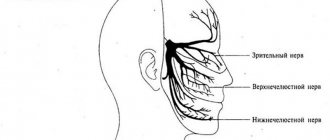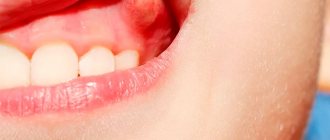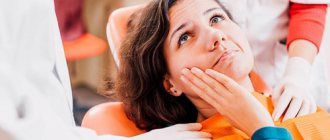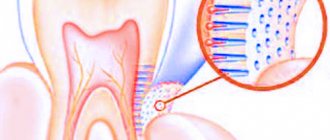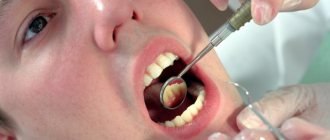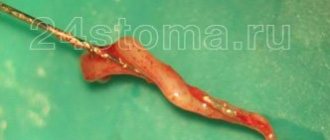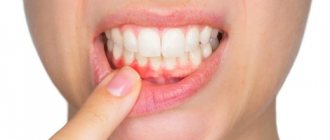What is trigeminal neuralgia?
Trigeminal neuralgia is one of the most severe and painful pains that occurs in the facial area. In some cases, patients are so exhausted by frequent and severe attacks that they become severely depressed and sometimes even commit suicide.
The trigeminal nerve provides sensitive innervation to the facial skin, oral mucosa, and all teeth on both sides. It is its branches that dentists numb during manipulations. In addition, it has motor branches for some masticatory muscles.
A characteristic attack of neuralgia is extremely severe, strong, shooting and sudden pain on one side of the face, like an electric shock, radiating to the jaw, eye, cheek, and teeth.
A classic attack may be associated with irritation of special trigger zones that excite the transmission of a pathological signal along the nerves. Sometimes it’s shaving, in some cases it’s the smell of perfume, and even the breath of wind. For what reasons does trigeminal neuralgia most often occur?
Massage techniques and methods
Techniques and methods of therapeutic massage are prescribed depending on the diagnosis made by the doctor.
Intercostal neuralgia
The patient lies on his back. At the beginning of the session, it is necessary to warm up the body - the massage therapist strokes the back with normal movements. Then more sharp stroking and kneading of the back is done from the upper to the lower part with a gradual transition to the sore areas. The latissimus dorsi muscle is affected by alternately stroking and kneading.
Massaging the ribs is carried out both on the back and in the chest area, the schemes are similar: gentle rubbing, stroking, squeezing. In order to thoroughly massage all the muscles and intercostal cavities, the massage therapist works with the pads of his fingers, directing them straight, in a circle or in a zigzag.
Chest massage includes the following techniques: rubbing, stroking, squeezing and pressing. At the end of the session, they again move on to massaging the latissimus muscle on the back using stroking, squeezing, kneading, and shaking methods.
Trigeminal neuralgia
The massage begins with alternate rubbing and stroking on the collar area, especially carefully massaging the back of the head, where many nerve endings are located. Next, proceed to facial massage. The scheme is as follows: stroking, rubbing in a circle, light kneading, vibration effects on areas with complete or partial loss of sensitivity.
Occipital neuralgia
Massage prescribed for the treatment of occipital neuralgia helps reduce pain and stop inflammation. The sequence of massage: back, neck, back of the head.
- Back. Techniques: stroking, squeezing, circular kneading of the longitudinal muscles, direct and circular kneading of the muscles located between the spine and shoulder blades.
- Neck and trapezius muscle. Techniques: stroking, squeezing, regular kneading, circular kneading with fingertips, kneading with phalanges.
- Back of the head. Techniques: regular and rake-like stroking, squeezing, straight, circular, zigzag rubbing with the pads or phalanges of four fingers.
Main Causes of Trigeminal Nerve Pain
The type of pain in neuralgia itself is special; it is associated with a pathological reaction of the nerve itself to an impulse that is not painful. Internally, it turns into a strong and abnormal, pathological pain.
Most often, the cause is the degeneration of the nerve after a herpes infection, which once appeared on the face, in the projection of the exit of the branches. Metabolic disorders, such as diabetes mellitus and polyneuropathy, as well as toxic polyneuropathy, for example, in chronic alcoholism, may also be the cause.
Very often, the patient finds himself in a situation where specialists simply do not understand the cause of acute and facial pain, and immediately give him an unreasonable diagnosis of trigeminal neuralgia. In fact, similar (but not the same) facial pain can be caused by completely different reasons not related to neuralgia. These are arthrosis of the temporomandibular joint, diseased teeth, pathology of the ENT organs, such as sinusitis, and even osteochondrosis of the upper cervical spine. Not one of these pains is neuralgia. These are so-called symptomatic pains.
Unfortunately, the opposite situation also exists: patients with real neuralgia are often sent to the dentist, and completely healthy teeth are removed, since the main complaints will be pain in the jaw and teeth.
Indications for massage
- Massage is indicated for almost all types of neuralgia, manifested in the following symptoms.
- Trigeminal neuralgia often occurs against the background of previous colds and inflammatory diseases or infections. It is expressed by repeated attacks of dull pain in the neck and head.
- Cutaneous neuralgia of the thigh is an unpleasant burning, stabbing pain or numbness in the outer thigh.
- Pterygopalatine neuralgia is constant severe pain in the area of the palate, temples, eyes or neck.
- Intercostal neuralgia - pain during sudden movements, coughing, sneezing.
- Occipital neuralgia is pain between the temples and the back of the head.
Diagnosis and treatment of neuralgia
The classic diagnosis of neuralgia is based on collecting anamnesis, identifying risk factors for the peripheral nervous system, the presence of reduced immunity, chronic colds and herpetic infections.
Then a neurological examination is performed, palpation of the places where the branches of the trigeminal nerve exit the skull. For the purpose of differential diagnosis, the patient is examined by a dentist or ENT doctor. Once the diagnosis is confirmed, the patient is treated for neuropathic pain.
First-line drugs are anticonvulsants: it all starts with carbamazepine, in some cases gabapentin or other drugs will be required. After relieving acute pain, long-term rehabilitation is necessary, using physiotherapeutic methods, the use of special compresses, and acupuncture. In some cases, the elimination of chronic muscle spasm in the projection of the upper cervical spine leads to improvement.
As a rule, when using an integrated approach, the patient experiences significant improvement, attacks become less frequent and occur faster. Only in severe and treatment-resistant cases does consultation with a neurosurgeon be required, since there are also surgical methods for treating severe trigeminal neuralgia.
| Consultation and diagnostics | |
| Appointment with a neurologist (examination-consultation) | 1,900 rub. |
| Consultation with a neurologist (repeated) | 1,400 rub. |
| Appointment with the head doctor (examination-consultation) | 2,800 rub. |
| Consultation with the chief physician (repeated) | 1,900 rub. |
| Repeated consultation with MRI interpretation | 1,200 rub. |
| Control by the chief physician, examination with the irt procedure | RUB 3,800 |
| Electrocardiogram with interpretation | 1,500 rub. |
*Prices are subject to change, as we always have promotions and special offers.
Neurologists leading the initial appointment
Titarchuk Andrey Borisovich Chief physician
Yurasov Pavel Aleksandrovich Neurologist
Find out the cost of treatment
Features of massage for neuralgia
- In the first days of the disease, massage is carried out in a gentle manner with a gradual increase in load in each subsequent session. Carrying out a deep massage is allowed only after the acute symptoms have subsided and the attacks of pain have subsided.
- At elevated body temperatures, massage is contraindicated.
- The effectiveness of the massage increases if it is done immediately after taking a warm shower (bath) or visiting the bathhouse. Before the massage, it is advisable to apply a warming ointment or cream to painful areas.
- It is not recommended to go out into the cold immediately after the session.
Causes and mechanism of development of neuralgia
The exact causes of the development of inflammatory processes in the fibers of the trigeminal nerve have not yet been established by medicine. However, it has been noted that most often the pathology occurs against the background of provoking factors - injuries, viral infections, inflammation, tumors, hypothermia, nervous shock or migraine attacks.
The appearance of neuralgia is preceded by a pathological change in the blood vessels supplying the nerve. Under pressure from deformed veins and arteries, the myelin sheath of the nerve loses its integrity, impairing its functionality.
The following symptoms indicate that treatment for damage to the trigeminal nerve is necessary:
- a feeling of itching, numbness or tingling in various parts of the face is a signal of an impending exacerbation;
- attacks of severe shooting pain, localized along the line of the nerve fiber - the eyes, the inner point of the eyebrows, temples, the area near the auricle, the back of the neck, teeth and gums;
- distortion of facial expressions;
- twitching of facial muscles.
Constantly waiting for an attack of pain makes a person live in tension and not only disrupts the usual way of life, but also often affects the state of his psyche.
Whereas timely contact with neurologists and adequate treatment of trigeminal neuritis allows you to correct the situation - relieve pain and feelings of physical inferiority, as well as restore mental and emotional balance.
HOW TO TREAT INFLAMMATION OF THE TRIGEMINAL NERVE WITH MAGOFON-01 APPARATUS
Treatment of trigeminal neuralgia involves pain relief with the help of antiepileptic drugs. You can enhance the effect of medications and increase the therapeutic effect by using the MAGOFON-01 device
The method of treating inflammation of the trigeminal nerve with the MAGOFON-01 device is designed for 7 days. Exposure time: 5 minutes during the first three days, 6 minutes on the fourth and fifth days, 7 minutes on the sixth and final days. The procedure is carried out once a day.
A second course of treatment is carried out after 30-40 days: it is also designed for 7 days. The time of exposure to the pain zone during a repeated course is 7 minutes on the first, fourth and fifth days, 8 minutes on the second and sixth days, 6 minutes on the third day and 10 minutes on the seventh day of physical treatment.
ADVANTAGES OF MAGOFON-01 IN THE TREATMENT OF INFLAMMATION OF THE TRIGEMINAL NERVE
Exposure to a magnetic field and acoustic vibrations can reduce the duration and number of attacks, and in the long term - completely get rid of the disease.
The use of the MAGOFON-01 device is indicated for the complex treatment of inflammation of the trigeminal nerve, since its effect enhances the effect of medications. MAGOFON-01 allows you to quickly relieve pain: by improving blood flow in the area of the affected nerve, the patient feels relief. The device is functional and has a wide range of applications. MAGOFON-01 can be used by members of the whole family to treat many diseases. MAGOFON-01 is easy to use and can be used both at home and in a hospital setting. MAGOFON-01
CAUSES OF INFLAMMATION OF THE TRIGEMINAL NERVE
In most cases, pain is caused by compression of the trigeminal nerve root by some vessel. 80% of patients who underwent neurosurgical intervention were relieved of pain through surgery to free the trigeminal nerve root from the vascular loop and place a special synthetic material between them (vessel and nerve).
However, the pathophysiology of the disease has not been fully studied and the question of the nature of the disease remains unclear - doctors only provide facts. Thus, a significant number of cases of trigeminal neuralgia are associated with multiple sclerosis. At the same time, 2.5% of patients with multiple sclerosis are diagnosed with trigeminal neuralgia, and 14% of them have bilateral inflammation of the trigeminal nerve.
In other cases, the cause of trigeminal neuralgia may be diseases of the teeth and paranasal sinuses, fractures, tumors in the mouth, nose, colds or glaucoma. Trigeminal neuralgia can occur as a result of injuries, chronic diseases of the gastrointestinal tract and intoxications of the body caused by kidney diseases, malignant tumors or other processes associated with deterioration of metabolism, general infections and intoxications, cerebrovascular pathology, narrowing of the infraorbital and mandibular canals. It is believed that the likelihood of the disease can be reduced through a healthy lifestyle, normal daily routine and good nutrition.

